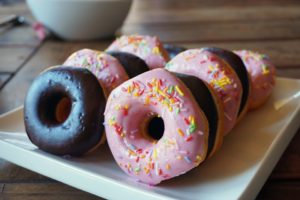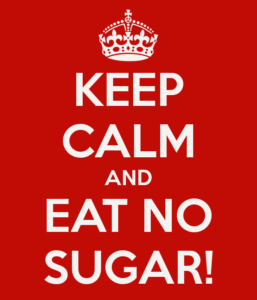
In lieu of “New Year’s Resolutions” which often get broken, Community Servings’ staff are taking part in a “No Sugar Challenge” this month. The goal of this challenge is to reduce overall sugar intake, and the best part – you can make the challenge fit for you. So whether you try it for a day, a few days, a week, or the whole month – join us as we welcome wellness in 2019!
The truth about sugar
Sugar has been blamed for contributing to America’s obesity epidemic. High consumption of sugar has also been tied to the rise in type 2 diabetes, cardiovascular disease, and several forms of cancer. Most people know that there is sugar in desserts and sweet beverages such as soda, energy drinks, and fancy coffee drinks. But many people are not aware of the hidden sugar lurking in seemingly unsweetened foods such as breads, yogurts, crackers, salad dressings, cereals, bacon… the list can go on and on. The point is, sugar is EVERYWHERE!
The nutritional guidelines for Americans state that adults should try to limit their sugar intake to less than 50g or 12 teaspoons of sugar per day, and even less for kids (around 25 g or 6 teaspoons). It doesn’t take long for most people to add up to 50g of sugar just by consuming a few everyday foods such as a latte, a granola bar, a sandwich, and a few tablespoons of ketchup. The truth is, most of us exceed 12 teaspoons of sugar every day by almost 50% and the CDC estimates many kids ages 2-18 are regularly consuming an average of about 81 grams of added sugar each day. As you can see, sugar consumption in America has gotten out of hand. But there’s good news: you can take control!

Take the “No Sugar Challenge”
If you’re interested in cutting back on sugar, try this challenge to reset your intake: Designate a week (or two) to eliminate all added sweeteners from your diet. This means reading ingredient lists on food labels to ensure that there are no added sugars in the foods. Sweeteners to look for, in addition to sugar, include: corn syrup and high fructose corn syrup, molasses, honey, maple syrup, agave, malt, brown rice syrup, dextrose, and other suspicious words ending in “ose.” It might seem cumbersome to have to check the label on everything (or ask restaurants about menu items) but you will be surprised to uncover the hidden sugar in so many of the things you regularly consume.
The no sugar challenge does allow for sugar that occurs naturally in things like fruits, vegetables, and unsweetened dairy products like milk, cheese, and plain yogurt, so you do not have to eliminate those. Make sure to check juice labels to ensure they are 100% juice and don’t have sweeteners added. It’s also a good idea to eliminate artificial sweeteners, such as those found in diet sodas and sugar-free candy, as these have also been linked to obesity and sugar cravings.
What will I gain by taking this challenge?
If you’re asking yourself why you should do this, here are several reasons to help motivate you:
Be sure to follow us on Facebook, Instagram, and Twitter as we share our no-sugar tips and recipes!
Written by Beth Kitzis, RDN, LDN,
Registered Dietitian at Community Servings